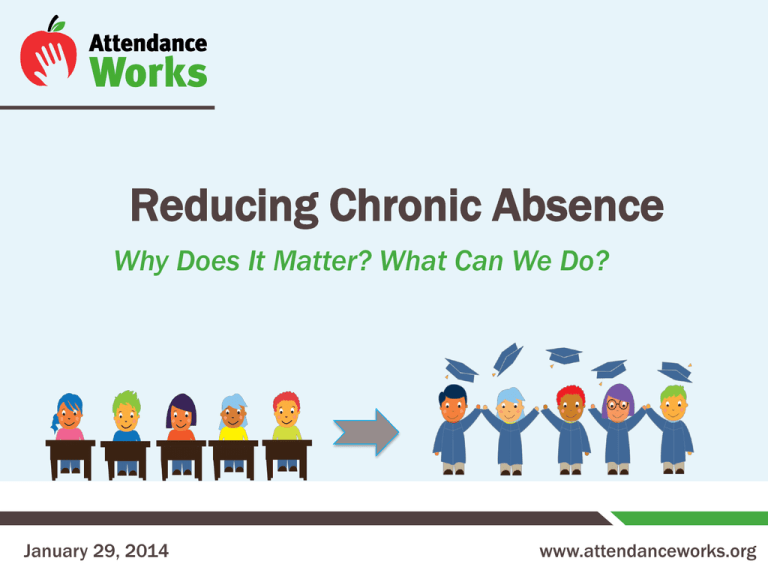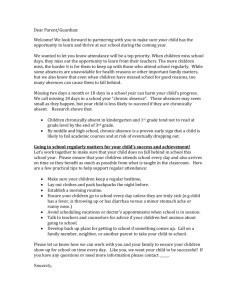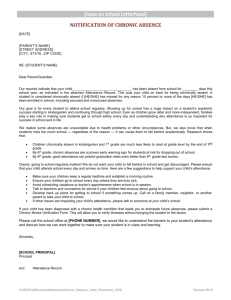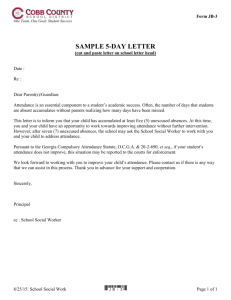What is Chronic Absence?
advertisement

Reducing Chronic Absence Why Does It Matter? What Can We Do? January 29, 2014 www.attendanceworks.org What is Chronic Absence? Attendance Works recommends defining chronic absence as missing 10% or more of school for any reason. Excused Absences Unexcused absences Chronic Absence Chronic absence is different from truancy (unexcused absences only) or average daily attendance (how many students show up to school each day). Suspensions 2 High Levels of Average Daily Attendance (ADA) Can Mask Chronic Absence 90% and even 95% ≠ A Chronic Absence For 6 Elementary Schools in Oakland, CA with 95% ADA in 2012 30% 30% 25% 26% 25% 20% 15% 10% Chronic Absence for 6 Schools in New York City with 90% ADA in 2011-12 12% 13% 13% 15% 16% 20% 20% 20% A B C 21% 23% 20% 15% 7% 10% 5% 5% 0% 0% A B C D % Chronic Absence E F D E F % Chronic Absence 98% ADA = little chronic absence 95% ADA = don’t know 93% ADA = significant chronic absence 3 Improving Attendance Matters Because It Reflects: Exposure to language: Starting in Pre-K, attendance equals exposure to language-rich environments especially for low-income children. Time on Task in Class: Students only benefit from classroom instruction if they are in class. On Track for Success: Chronic absence is a proven early warning sign that a student is behind in reading by 3rd grade, failing courses middle and high school, and likely to drop-out. College Readiness: Attendance patterns predicts college enrollment and persistence. Engagement : Attendance reflects engagement in learning. Effective Practice: Schools, communities and families can improve attendance when they work together. (For research, see: http://www.attendanceworks.org/research/) 4 Starting in PreK, More Years of Chronic Absence = Need for Intensive Reading Support By 2nd Grade Some risk At risk * Indicates that scores are significantly different from scores of students who are never chronically absent, at p<.05 level; **p<.01; ***p<.001 5 Attendance Is Key To Laying A Foundation For 3rd Grade Reading 6 Multiple Years of Elementary Chronic Absence = Worse Middle School Outcomes Each year of chronic absence in elementary school is associated with a substantially higher probability of chronic absence in 6th grade 18.0x Increase in probability of 6th grade chronic absence Chronic absence in 1st grade is also associated with: 7.8x 5.9x • • Lower 6th grade test scores Higher levels of suspension Years of Chronic Absence in Grades 1-5 Oakland Unified School District SY 2006-2012, Analysis By Attendance Works 7 The Effects of Chronic Absence on Dropout Rates Are Cumulative With every year of chronic absenteeism, a higher percentage of students dropped out of school. http://www.utahdataalliance.org/downloads/ChronicAbsenteeismResearchBrief.pdf 8 Chronic Absence in High School Predicts Lower College Persistence In Rhode Island, only 11% of chronically absent high school students persisted into a 2nd year of college vs. 51% of those with low absences. Rhode Island Data Hub: May 2014 9 How Can We Address Chronic Absence? Find Out Why Students Are Chronically Absent Myths Absences are only a problem if they are unexcused Sporadic versus consecutive absences aren’t a problem Barriers Child struggling academically Chronic disease Lack of engaging instruction Lack of access to health or dental care Poor transportation Attendance only matters in the older grades Aversion No safe path to school Poor school climate and ineffective school discipline Parents had negative school experience 11 Going to School Every Day Reflects When Families Have … Hope for a better future + Faith that school will help you or your child succeed + Capacity Resources, skills, knowledge needed to get to school 12 AW Recommended Site Level Strategies 13 Improving attendance requires adoption of a tiered approach that begins with prevention TIER 3 Students who missed 20% or more of the prior school year (severe chronic absence) • Intensive case management with coordination of public agency and legal response as needed High Cost Truancy interventions TIER 2 Students exhibiting chronic absence (missing 10%) TIER 1 All students • Provide personalized early outreach • Meet with student/family to develop plan • Offer attendance Mentor/Buddy • Recognize good and improved attendance • Educate & engage students and families • Monitor attendance data • Clarify attendance expectations and goals • Establish positive and engaging school climate Low Cost 14 Tier 1: Communication, Education, and Engagement Parent Video & Discussion Guide • SETTING THE STAGE • VIDEO (6 minutes) • FACILITATED CONVERSATION – THE CONSEQUENCES OF CHRONIC ABSENCE – HOW TO IMPROVE ABSENTEEISM • • • • FAMILY PRACTICE INCREASE SOCIAL CAPITAL IDENTIFY HOW SCHOOL CAN HELP COMMUNITY SERVICES Discussion: When and where might you use these materials with a family or a group? 16 Criteria for Identifying Priority Students for Tier 2 Supports Chronic absence (missed 10% or more of school) in the prior year, assuming data is available. And/or starting in the beginning of the school year, student has: In first 2 weeks In first month (4 weeks) In first 2 months (8 weeks) 2 absences 2-3 absences 4 absences Missing 10% any time after 17 Possible Tier 2 Interventions Partner with families/students to develop Student Attendance Success Plan Assign Attendance Buddies Recruit for engaging Beforeor After-School Activities Positive Linkages and Engagement for Students and Families Connect to Walk- to-School Companion Offer plan or contacts for Health Support 18 Tools for Tier 2: The Power of Positive Connections 19 Ingredients for System-wide Success & Sustainability District Community Conveys why building a habit of attendance is important and what chronic absence is Positive Messaging Schools Actionable Data Is accurate, accessible, and regularly reported Students & Families Ensures monitoring & incentives to address chronic absence Shared Accountability Capacity Building Strategic partnerships between district and community partners address specific attendance barriers and mobilize support for all ingredients Expands ability to interpret data and work together to adopt best practices 20 Lessons learned from other communities 21 Kent School Services Network (KSSN) Interdisciplinary attendance teams: Attendance teams meet weekly to monitor attendance trends and intervene with students who are chronically absent or headed off track. Teams typically include a DSS worker, community school coordinator, principal, nurse, attendance secretary and family support specialist. • Coordination of services: KSSN schools are community service centers offering health, mental health, dental and vision services to low-income families. They also connect families to churches, businesses & other organizations that offer supports. • Student and family engagement: KSSN schools engage families in improving attendance through one-on-one outreach, attendance incentives and parent involvement activities. 22 KSSN Insights into Elements of Success • Superintendent and Principal Leadership • District and Building Attendance Policy • Teacher/Staff Buy-in • Regular Attendance Meetings • Parent Outreach • Attendance Incentives • Interagency Casemanagement • Year End Assessment 23 Improvement is possible; implementation matters Axis Title Absenteeism Trends Overtime in KSSN Schools 50.0% 45.0% 40.0% 35.0% 30.0% 25.0% 20.0% 15.0% 10.0% 5.0% 0.0% Alger Middle Burton Elementary Coit Creative Arts Harrison Park Martin Luther King Sibley 24 The Response: Interagency Task Force Established in 2010 by Mayor Bloomberg and comprised of the Mayor’s Office, Department of Education, and various other city agencies • Key Aspects: • Using Data to Measure, Monitor, and Act • Success Mentors • Principal Leadership • New Models for Connecting Community Resources to Schools • Promoting Awareness • Incentives, Recognition, and Response • Accountability Strategies to Sustain Efforts MAYOR’S INTERAGENCY TASK FORCE 25 Success Mentor Models • Three Models: Developed with Nationally Recognized Leaders • External: Community-based Organizations • E.g. City Year, Social Work Students, Retired Professionals • Internal: School Staff • E.g. Teachers, Guidance Counselors, Social Workers, Classroom Teachers, Administrators • Peer-to-Peer: Students • E.g. High school seniors/juniors mentoring freshman MAYOR’S INTERAGENCY TASK FORCE 26 Success Mentors’ Responsibilities • Target Students • Success mentor assigned “target” students who were chronically absent the year prior, and is matched with these students early in year, for full year. • School-Wide Strategies • • Promote a positive school-wide culture that encourages all students to attend and achieve. Principal’s Weekly Student Success Meeting • • Attend the weekly meeting and collaborate with school partners to support mentees. Parental Engagement • • Work with families to share importance of attendance, and call home for every absence. Interact with parents to celebrate students’ success whether big or small. MAYOR’S INTERAGENCY TASK FORCE 27 Key Finding: Task Force Schools Significantly Reduced Chronic Absenteeism • All three cohorts of task force schools consistently outperformed comparison schools. • Positive impacts were consistent across elementary, middle, high schools, and alternative schools. • Impacts greatest for students who benefit most from being in school: high poverty students & students in temporary housing. MAYOR’S INTERAGENCY TASK FORCE 28 Key Finding: Success Mentors & Supporting Infrastructure Substantially Improved Student Attendance • Students with prior histories of chronic absenteeism with a Success Mentor gained nearly two additional weeks of school (9 days), which is educationally significant. • In the top 25% of schools, students with Success Mentors gained one additional month of school. • High School students with Success Mentors (including those overage for their grade) were 52% more likely to remain in school the following year. • Mentees reported they liked having a mentor and the mentor helped improve their attendance, schoolwork, motivation, and confidence. MAYOR’S INTERAGENCY TASK FORCE 29 New Britain, Connecticut • Professional development: site administrators and teams trained to interpret attendance data, adopt best practices and engage in peer learning. • Actionable data: sent report every 10 days with information on how many and which students are chronically absent • School attendance teams: monitored the data and ensured appropriate supports are in place. • Home visits: hired two outreach workers to conduct home visits to chronically absent kindergartners. • Parent engagement and communications: Messaged thru newsletters, daily interactions with parents & attendance incentives. • Community partnerships: used community agencies to offer supports at school sites and thru a district Attendance Review Committee formed to avoid referrals to juvenile court. What was the impact in New Britian? Chronic absence dropped from 20-13% for K-8 in year 1 ; progress sustained in year 2. 50% 45% 40% 35% 30% 11-12 12-13 13-14* 25% 20% 15% 10% *School year 13-14 represents 140 school days 5% 0% K 1 2 3 4 5 6 7 8 9 10 11 12 31




